Editorial
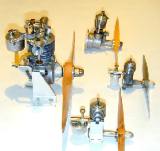
Welcome to 2005, and before you ask me where 2004 went, let me assure you that I have absolutely no idea whatsoever. Looking back I find that I'm not greatly impressed with my own output for the year—pictured here: the 15cc Feeney replica (still un-run), the Mills 1.3 Mk I series I replica, the Mills P75 replica, and a Pepperell "seven-sixteenths" replica (seems to be a pattern emerging here...) Sadder still is the fact that the latter three were started and completed within the last ten weeks! There have been some restoration jobs completed, but it seems a poor accomplishment for an entire year, especially as no models got built either. If there's a positive, my team of software engineers (Did you see them? Who were they? What were they doing? Which way did they go? Tell me quick, for I am their manager...) and I have done some great work on the "-ilities" I keep harping on (maintainability, reliability, scalability, some others). These come at a cost, and if that equates to less time spent modeling this year, sobeit.
Another long-term project I've had the honor to have contributed to is also drawing to a conclusion; specifically the Vance Integral Edition (half of which graces the top shelf on the right in the library picture below). This labor of love has seen the collection, digitization, sanitization, and re-publication of author Jack Vance's entire oeuvre. I fully expect at least one PhD to be awarded not to our effort, but to someone who analyses the saga, which is an entirely new accomplishment made possible by the Internet. I'd seriously think about it myself if it (1) wasn't so far outside my field, and (2) I was not so burnt out by my comparatively small part in the adventure. Still, it is an accomplishment, and an excuse! 
As for other stuff, I've totally failed to reorganize the left-hand navigation bar as promised, but read the next item for my lame excuse. The MEN ONLY CD is no closer—perhaps even further away as I now realize the only way I can make it look and feel the way I want is to either require users to install a local "web server" (like Tomcat), or provide a mini-web server as part of the CD. To quote an obscure 70's cartoon show, "You knew the job would be difficult when you took it, Fred". And if you recognize that one, you're at least as sick as I am!
So re-reading the above, and thinking of the almost incomprehensible scale of woe and human tragedy that a small geological realignment has inflected on our near northern neighbors here, it's been a good year for me and I have absolutely no cause whatever for complaint. The little web site pulls a stable hit rate of about 8K per month and enough seem to find sufficient joy in what I present to occasionally say thanks (please don't all suddenly decide to say thanks—writing the replies would totally swamp me!) My resolutions for 2005 are: Run the Feeney, finish the Mortons, make an S75 and an Elf Corncob—and between time, be a better person, suffer fools gladly (hah!), and maybe find a cure for the common cold.
1001 Alsatians
Oops. Instead of making the left-hand navigation bar simpler this month (as promised), I've managed to make it more cluttered and complex by adding another hard to find item. Just above the "Home" link at the bottom is a new reference to the new Model Engine Review Index Page. The impetus for this addition and how it developed in described in the Review History Page, together with details of how to use the advanced search and filter facility for the page (yup, you guessed it more ugly, horrible, un-maintainable, but effective Perl scripting).

Now to make some tenuous connection with the title for this news item, I'd wanted to say that the index contained one thousand and one reviews from dog-eared old magazines, but I got carried away in the library and it actually contains 1300 reviews. That's The Library pictured here (with two more sets of shelves out of picture to the left), though many of the reviews came from the Mountain of Magazines which live in boxes, in storage, so it 'twer not as simple and pleasant as it looks. I've learnt a few things in the process—like the propensity for European 2.5cc engine designers to use a 15mm bore with a 14mm stroke to give 2.47cc displacement (0.151 cuin). The addition of the index page has slowed down the Site Search Utility response time, but I felt that including the names of all these engines in a search was worth the extra delay. And it was fun for me to see who had reviewed what over the years. I hope you can find a thing or two of interest in it too.
World Exclusive! New kit from Classic Engines
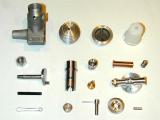
You read it here first, probably. Roger Schroeder's Classic Engine range will soon get a new addition—namely a full size replica kit for the famous Mills P75. I was lucky enough to spend the early part of December making a pre-production prototype of the kit. As a result, Roger revised a few things to make life easier for builders and has Ok'd this announcement. The P75 construction will be serialized in The Engine Collectors Journal in 2005. Judging by how quick and how well the little Mills went together for me, this one will be a real hit with engine builders. A set of castings will be a mere US$20 and will be available when the first part of the series appears in ECJ. After the series has completed, a full kit including plans and instructions will be US$30.
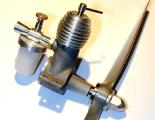 After working through a few problems that others now won't see, my example is a terrific little performer. It turns a Cox 7x3.5 plastic prop steadily at 10,200 rpm. This is considerably better than the Indian K75 replicas I've handled and an improvement on the original too! It can reliably be backed off to 4,500 rpm by decreasing the comp, and it'll swing a 9x4 wood at 5K, just like the originals. Complexity wise I'd call it a *almost* beginners' kit. The qualifier is because it requires the manufacture and heat treating of a special cutter. Certainly anyone with some model engineering experience, but no IC building behind them should have no great trouble. Still, making the cutter is not that difficult, and Roger will supply full details in his ECJ series. I tried an experiment on this engine and the Pepperell replica: using a steel piston running in a steel liner with almost no taper. So far, it's exceeded expectations, but I want to try it a couple more times before recommending it as an alternate to the usual cast iron piston in tapered steel cylinder.
After working through a few problems that others now won't see, my example is a terrific little performer. It turns a Cox 7x3.5 plastic prop steadily at 10,200 rpm. This is considerably better than the Indian K75 replicas I've handled and an improvement on the original too! It can reliably be backed off to 4,500 rpm by decreasing the comp, and it'll swing a 9x4 wood at 5K, just like the originals. Complexity wise I'd call it a *almost* beginners' kit. The qualifier is because it requires the manufacture and heat treating of a special cutter. Certainly anyone with some model engineering experience, but no IC building behind them should have no great trouble. Still, making the cutter is not that difficult, and Roger will supply full details in his ECJ series. I tried an experiment on this engine and the Pepperell replica: using a steel piston running in a steel liner with almost no taper. So far, it's exceeded expectations, but I want to try it a couple more times before recommending it as an alternate to the usual cast iron piston in tapered steel cylinder.
New Books and Magazines This Month
While there was nothing new into the library this month, the library itself got a good going over to create the Index of Model Engine Reviews, and the new FAQ question on Compression Ratios for Model Engines. Part of the research for the latter came from a rather old volume that can still occasionally be found second hand, so lacking anything better, I'll review that.
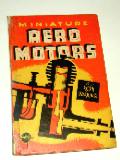 The work in question is Ron Warring's "Miniature Aero Motors", published by Ian Allen Ltd, London, 1949, before ISBN's came into vogue. The publishing house was also responsible for "Model Aeronautics", "Model Aviation Power Models", and the "Model Planes Annual", although to my knowledge, the Annual appeared only in '49 and '50. Ron Warring took over from Lawerence Sparey as the Aeromodeller's engine reviewer in 1953, staying in that role until 1963. All told, he prepared 140 engine reviews for the Aeromodeller during his tenure.
The work in question is Ron Warring's "Miniature Aero Motors", published by Ian Allen Ltd, London, 1949, before ISBN's came into vogue. The publishing house was also responsible for "Model Aeronautics", "Model Aviation Power Models", and the "Model Planes Annual", although to my knowledge, the Annual appeared only in '49 and '50. Ron Warring took over from Lawerence Sparey as the Aeromodeller's engine reviewer in 1953, staying in that role until 1963. All told, he prepared 140 engine reviews for the Aeromodeller during his tenure.
In his foreword, Warring dates his experience with model engines as 1936 when one SJ Colyer (later the proprietor of Majesco Motors) obtained an early Brown Junior from the USA. He observes that quantity production had reached such heights in 1949 that he felt the need of an engine book written for the model flyer, rather than the model engineer. So in this little book's 160 pages (it's "pocketbook" size; only 4.75" x 7.25"), Warring provides five chapters that describe a model engine's general parts and construction, three on operation, then another five on various topics including propellers, testing and jet types (Jet-X having been recently introduced in the UK). He closes with an appendix giving the full size "GA" for selected British and American engines, followed by another that comprehensively tabulates bore, stroke, weight, cost, mounting dimensions etc for most of the British and American engines of the time.
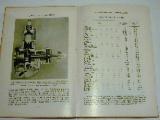 After stating that he proposes to keep the material in the book to a "practical" form, his first chapter on Definitions and Classifications, having described geometric compression ratio, presents a table showing the bore/stroke and compression ratios of a number of American ignition and glow engines, plus three English engines—the latter understandable as most English engines of the time were compression ignition. Whatever, the table is most welcome as this sort of information is seldom provided today and gives us in insight into design practices of the various manufacturers.
After stating that he proposes to keep the material in the book to a "practical" form, his first chapter on Definitions and Classifications, having described geometric compression ratio, presents a table showing the bore/stroke and compression ratios of a number of American ignition and glow engines, plus three English engines—the latter understandable as most English engines of the time were compression ignition. Whatever, the table is most welcome as this sort of information is seldom provided today and gives us in insight into design practices of the various manufacturers.
The chapters on operation have a certain historical value, but are very dated. However the early chapters on construction and the appendices are certainly of research use. In fact, I've probably been saved from another broiled crow and chips evening by a note in the chapter on carburetion. Here Warring notes "..a few motors are fitted with a small bleed hole in the intake between the needle valve and the intake port, so that full choking is virtually impossible." I had read just such a claim in a contemporary American review of the Mills .75cc diesel and was going to make some very disparaging remarks on folk who wax lyrical on things they don't understand. I still will, but to a lesser degree, as the reviewer has in fact mistaken the cut-off spring anchor point for a bleed hole. But he was apparently aware of a practice, described in Warring's book, that I knew nothing about! So, a dated but valuable little book worth chasing down, if you like this sort of thing.
Update: Son of EZE
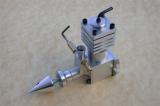
Last month, I showed a picture of Joe Webster's ML Midge and his 3D CAD rendering of an clean-room EZE/Little Dragon design. The way Joe was going, it looked like he'd have it running before the end of the month, and he has! After some initial problems starting, Joe has it running at 8600rpm. He reports that he was targeting for exhaust and transfer durations of about 130/110, but ended up with something like 155/130. This is not going to help starting, and will rob him of some power, but hey! It runs! That's a terrific effort for his second motor—to not only build it but design it as well, even if the outward appearance comes from way back. The Lil' Dragon was designed by Roy Clough Jr and some of his advice on diagnostics appeared in the November 1950 issue of Model Airplane News. For those who don't have that, the salient parts were extracted and repeated here in the February 2003 Issue of Model Engine News. Here he describes what happens if the exhaust opens too late with regard to transfer, but not specifically what Joe is seeing.
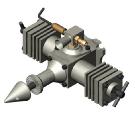 But wait, as they say, there's more! Even before the Son of EZE was screaming, Joe was playing with new 3D models, and knowing my weakness for twins, tantalizing me with concepts for in-line and boxer EZEs. The one shown here would use reed valve induction and a two-piece crankshaft along the lines of the G-Mark twins, if it can all be fitted into the very limited space available. The G-Mark design got around the need for split big-ends on the rods, like the Craftsman Twin, or brazing up a "full" two-throw crankshaft from 3 pieces with captive rods like the Schroeder Simple Twin.
But wait, as they say, there's more! Even before the Son of EZE was screaming, Joe was playing with new 3D models, and knowing my weakness for twins, tantalizing me with concepts for in-line and boxer EZEs. The one shown here would use reed valve induction and a two-piece crankshaft along the lines of the G-Mark twins, if it can all be fitted into the very limited space available. The G-Mark design got around the need for split big-ends on the rods, like the Craftsman Twin, or brazing up a "full" two-throw crankshaft from 3 pieces with captive rods like the Schroeder Simple Twin.
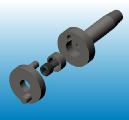 Instead, they used a two piece crank where the rear section is a disk with two pins that is cam-locked into the front section with a cap head screw. Although this looks delicate, it obviously works and works well—though it will have the benefit of being hardened and ground which home shop parts seldom are. Bert Striegler points out that the forces on the crank are essentially balanced due to the opposed firing configuration, so the joint is not as highly stressed as it at first seems. If this design goes any further than the neat image rendering, you'll read about it here. And thanks to Joe for preparing the 3D CAD shots seen here.
Instead, they used a two piece crank where the rear section is a disk with two pins that is cam-locked into the front section with a cap head screw. Although this looks delicate, it obviously works and works well—though it will have the benefit of being hardened and ground which home shop parts seldom are. Bert Striegler points out that the forces on the crank are essentially balanced due to the opposed firing configuration, so the joint is not as highly stressed as it at first seems. If this design goes any further than the neat image rendering, you'll read about it here. And thanks to Joe for preparing the 3D CAD shots seen here.
Bargin Myford Super 7B
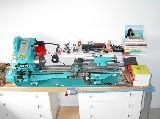
Bargin? Myford? same sentence? Has Chernich has gone completely around the twist at last? Not so. Just noticed that Guy Lautard, author of the Machinist's Bedside Reader series is assisting in an estate sale of the greatest bargain of the century (so far  ): a new, fully set-up and optioned, unused, long bed Myford Super 7B. By "new", I mean the one with the redesigned spindle providing 1" clearance through the headstock with a 4MT taper. The accessories include things I didn't even know Myford provided, like a zeroable, calibrated (.001) tailstock micrometer—must be sort of like the GHT designed one I fitted to my own Myford. Accessories include a Grip-Tru 5" 3JSC and 6" 4JI chucks, 5C collets, metric conversion set, etc, etc, et-bloody-cetra! It's not cheap, but if I was still living in the US, I'd snap this one up regardless of whether I had a lathe or not! The rest of us can drool...
): a new, fully set-up and optioned, unused, long bed Myford Super 7B. By "new", I mean the one with the redesigned spindle providing 1" clearance through the headstock with a 4MT taper. The accessories include things I didn't even know Myford provided, like a zeroable, calibrated (.001) tailstock micrometer—must be sort of like the GHT designed one I fitted to my own Myford. Accessories include a Grip-Tru 5" 3JSC and 6" 4JI chucks, 5C collets, metric conversion set, etc, etc, et-bloody-cetra! It's not cheap, but if I was still living in the US, I'd snap this one up regardless of whether I had a lathe or not! The rest of us can drool...
New Gallery Entries
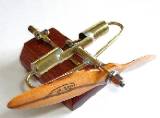
Just in case you were wondering where Les Stone's new engine pictures are for this month, rather than try and shoe-horn them into this page, they've been added to a new page of the Gallery. Les provided shots of some of his past IC projects. These are the Top .23, Dooling 61, and Cave Cobra reproductions. Les also sent along a picture of his Pachasa air engine, circa 1928, as seen here. There will be more on this in a forth coming issue, but for now click on the pic, or follow the link to the Les Stone Tribute Page.
Found it!
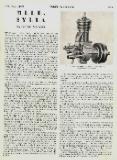
While OCR'ing the ET Westbury 2-stroke article, his reference to Gems Suzor and his remarkable transfer scheme caught my eye. I just *knew* I'd scanned an article on this engine, but do you think I could find it? Well, while cleaning up my directories of large junk files, the missing scan came to light. Here it is, "fresh" from the pages of the Model Mechanic for Dec/Jan 1947, and written by Suzor himself. No chance of fitting a muffler to this one!
Another Pepperell
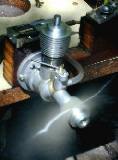
Ken Croft was first to complete a Pepperell Seven-sixteenths replica from the die castings made by Eric Offen. Here's the second, made in a leisurely five days starting on Boxing Day, 2004. By the time you read this, the Pepp will have gone off to a collector in trade for something I wanted badly enough, but first it got a quick run and confirmed Ken's findings: the Mickey-Mouse air-valve replacement for the conventional needle and spray-bar works just fine, and the engine is a smooth, strong runner that would have been almost unfairly competitive with English engines of the time! Again, I tried a steel piston in a parallel steel liner (see the P75 World Exclusive in this issue) and the results appear positive, though both share a characteristic I'm not happy with, so at least one more example of the Pepp, with a cast iron piston for comparison will be required—besides, I need one for my collection!
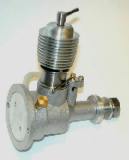
This one is made exactly to the plans, which are as close to the original as makes no difference. Ken made some very sensible changes, like reducing the shaft OD from a heroic 3/8" so he could fit a bronze bush (the original runs the shaft in the unbushed aluminum case casting), and using a split cone to grab the prop driver. Mine uses a squared section on the shaft to key a broached square hole in the driver. If you sit down with just a needle file for this job, it can be painful and unattractive, but there's an easy way that Roger Schroeder and I wrote up years back in SIC. When I build the second Pepp (which will go into my permanent-don't-even-ask collection), I'll document the build photographically, including how to broach square holes with no fuss, no mess, no complicated tooling, and no 20 tonne hydraulic press! Sounds like a good Tech Tip Topic...
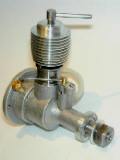
Only real problem with the Pepp is preventing the crankcase "pump" from stealing raw fuel from the integral tank through the internal backplate thread. Being anxious to see it run, I ran from an external tank (as seen above), Ken having alerted me to this problem. The cure is a good gasket, but with a width of about 1/32", such a gasket is hard to make, unless you care to make a punch set for a single gasket. I think an O ring would be a better idea. Pulling off the external backplate after 5 minutes running showed the tank volume to contain raw fuel—obviously pumped out of the case rather than transferred, so if the integral tank had been used, you can bet it would have sucked and blown. I also used a "conventional" contra-piston instead of my usual "DCO" spring-fit contra and conclude once and for all that this is for the birds. All would-be initiates of the oily-hand should read about the DCO method of contra-piston fitting in the FAQ and never be tempted to stray. I certainly won't, ever again  .
.
Engine Of The Month: Mills .75

Last month, we looked at all the reviews that has been written on the venerable Mills 1.3, the first model engine produced by the company, "Mills Bros (Model Engineers) Ltd" in 1946. So it seems reasonable to follow up this month with their second and most popular product, the Mills .75cc diesel. The choice is made even more timely by completion of a replica of this engine from the soon to be released Classic Model Airplane Engine kit. As with the 1.3, so much has been written by so many about this engine, that my own comments would be rather redundant, but with the help of the giant Engine Review Index, I was able to look over the other reviews and pick some aspects that are less well known, or controversial. Click on the photo to go to the review, or select the engine from the Engine Finder.
Morton M5 Update
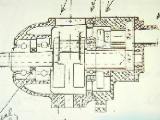
No (alas), not my too long delayed M5 project (but that will get attention Real Soon Now)—rather Bruce Satra of Vernal Engineering has just mailed out an updated set of M5 drawings. These show changes to the push rods, valve cages, roller tappets, crankshaft, leadshaft and its bearing system. The shaft changes have been devised by Bob Roach, the Australian designer of the scale Pratt & Whitney Wasp Jr. for which Vernal supplies the investment castings. As well as vastly improved balancing, the revision includes a new ball race that provides full support for the leadshaft, ahead of the cam ring. The new valve cages follow Bruce's M1 adaptation, being permanently glued into the heads. I rather like the removable cages of the original design with their ring-nuts, but perhaps having already made 20 of the damn things has something to do with it. Still, I have to agree that the revision makes a *lot* of sense as tapping the blind holes for the lock nuts is one of the harder head machining tasks. The drawing set includes revised jigs for machining the cylinder heads which again is simpler than the previous design. All in all, Bruce is making building the M5 far easier, and the engine more reliable. The original Mortons cunningly self-limited to 4000 rpm by breaking slave rods. Bruce's revised rods allowed operation to 5000 rpm. With the new revisions, Bruce says that the M5 can operate reliably at 6000 rpm—a 50% increase on the original limit. His work on this venerable design, and Vernal's beautiful castings deserve all the praise I can heap.
Tech Tip of the Month
Twice in the past month the same question has popped up, once on the Yahoo Min-Int-Comb-Eng web list, the other in a private email question from a reader: what should the compression ratio for a model engine be, and is it calculated (on a two-stroke) from after the exhaust post closes? Two in one month is enough to justify a new entry in the Model Engine FAQ, so that's where you'll find "the", or perhaps I should qualify and say "an" answer.
 1001 Alsations
1001 Alsations
 World Exclusive! New kit from Classic Engines
World Exclusive! New kit from Classic Engines
 Update: Son of EZE
Update: Son of EZE
 Bargin Myford Super 7B
Bargin Myford Super 7B
 New Gallery Entries
New Gallery Entries
 Found it!
Found it!
 Morton M5 Update
Morton M5 Update
 Another Pepperell
Another Pepperell
 Editorial
Editorial
 New Books and Magazines This Month
New Books and Magazines This Month
 Engine Of The Month: Mills .75
Engine Of The Month: Mills .75
 Tech Tip of the Month
Tech Tip of the Month
 Standard Stuff
Standard Stuff

















